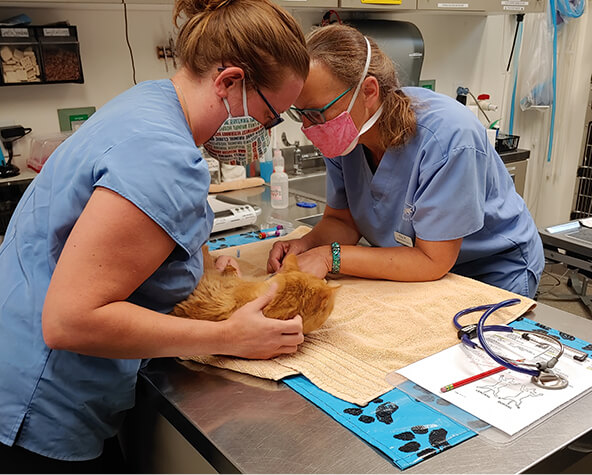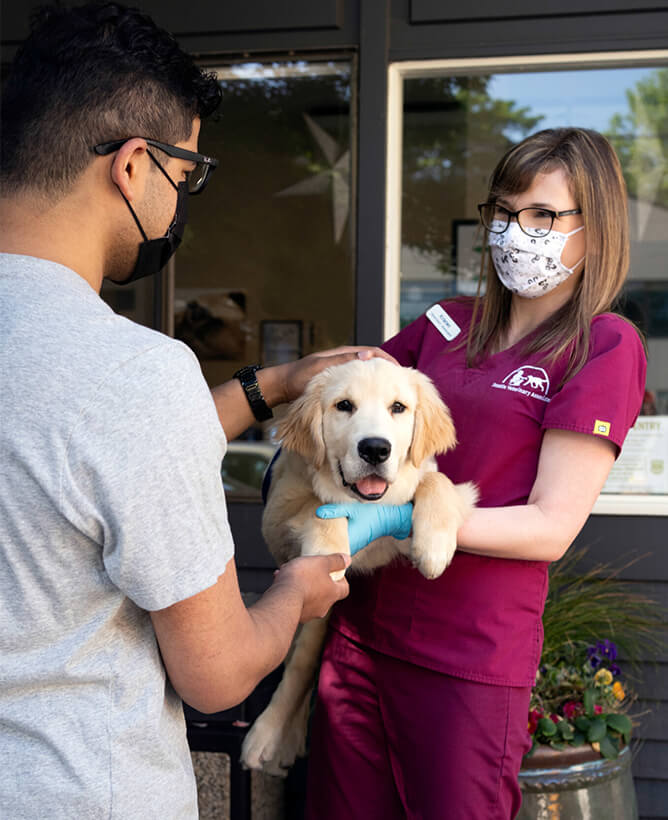
Your pet's safety is our number one priority.
– Our skilled doctors will develop a surgical, anesthetic, and pain management plan customized to your pet.
– We want to keep your pet safe, calm, and comfortable throughout their visit.
– Pre-surgical physical examination is a necessary first step to every pet’s anesthetic plan.
– Blood tests are recommended for all of our patients prior to procedures to increase the chance of detecting unknown illness that can make anesthesia dangerous.
Your pet’s safety is our number one priority.
The first step in any health care plan is for our caring doctors take the time to evaluate your pet physically. During this visit the doctor will perform a physical exam and consult with you about your concerns for your pet. Based on the findings and your conversation as well as taking into account your pet’s breed, age, and previous medical history they may propose an anesthetic procedure as the best option for your pet. If this is the case, they may also recommend additional laboratory testing prior to anesthesia. Once all of the information has been gathered the doctor will follow the most up-to-date research and recommendations to develop a surgical, anesthetic, and pain management plan customized to your pet. With careful consideration toward keeping your pet safe, calm, and comfortable throughout their visit our doctors prepare their plan to balance the ideal selection of sedatives, pain medications, local and regional treatments, and injectable or inhaled general anesthetics. Because each procedure and anesthetic plan is personalized the process described here may differ slightly for your pet.
Hospital admission is a valuable part of the pre-anesthetic process.
Anesthetic events are usually scheduled at least a few weeks in advance. In the days leading up to the surgery every owner will receive a reminder either via email, text, or call to remind you when and where to admit your pet and to review instructions including withholding food after 10 PM the night prior to surgery. The admission process is the next important step in keeping your pet safe during surgery. This is our final check in to make sure the surgical plan we have in place matches your understanding of what your pet needs, that we know when your pet was last fed, which medications have or have not been given, and collect any other important information– including a way to contact you with any additional questions, clarifications, or updates while your pet is with us.
The process for general anesthesia.
Only veterinarians and licensed veterinary technicians prepare and administer anesthetic agents to ensure your pet’s safety. In most cases, the first step in anesthetic induction begins with an injection that sedates and controls pain during and after the procedure. Your pet will be given an intravenous (IV) catheter while under the influence of a mild sedative. Once the IV is in place, your pet is given a second relaxing agent through the IV to allow an endotracheal tube to be passed. The endotracheal (ET) tube is used to administer the anesthetic gas.
Supportive measures we use to keep your pet safe.
There are many general safety measures in place within the hospital that affect surgical patients, but we will only cover those that are specific to surgery. The first crucial safety measure is the placement of the IV catheter through which we give intravenous fluids. The fluids support your pet’s blood pressure as well as having the added benefit of helping your pet flush the anesthetic medications from their body after surgery. The IV catheter also grants direct access to your pet’s vein to give routine or emergency medications.
While your pet is under anesthesia they are unable to swallow so part of the reason we place an ET tube is because it seals off your pet’s airway. This means your pet does not inhale fluids or foreign materials while asleep which can cause aspiration pneumonia. The ET tube allows us to deliver oxygen along with the anesthetic gas so we can keep their blood oxygen at a safe level.
Lastly, we also help your pet maintain their temperature and enhance blood circulation through the use of forced-air warming blankets and circulating warm water pads. Both of these warming methods are specifically designed with immobile patient safety in mind as it eliminates concerns of contact burns many other arrangements have been known to cause.
Our attentive monitoring is an essential part of your pet’s health.
Once your pet is admitted, they will receive a brief physical examination and two checks of their vitals before any medications are administered. A staff member is assigned to your pet when the first medication is given. That team member will be by your pets side until they begin to ease into a very drowsy state. While the IV catheter and ET tube are placed a staff member will manually check your pet’s vitals until monitoring leads can be attached. The same machines used in human medicine are used to observe and record respiratory and cardiac rate, heart beat pattern, blood pressure, body temperature, and blood oxygen and carbon dioxide levels. Throughout your pet’s procedure their vitals are viewed routinely by the doctor, technician, and/or assistant involved with your pet’s procedure and also documented at regular intervals. By keeping a record of your pet’s vitals trends are quickly noted and can be acted on before they become a problem. At the end of the procedure your pet is removed from inhalant anesthesia and begins the recovery process. A staff member continues to monitor your pet as they wake up removing their ET tube, continuing to check their vital signs, reflexes, and alertness. Monitoring tapers off in intensity as their mobility and awareness improves until they are able to comfortably go home.
Post Anesthetic Care Matters
Before you take your pet home one of our staff members will review your pet’s post-anesthetic care needs. You will get a printed document with this information as well. Not every anesthetic procedure requires a follow-up visit but if yours does we will let you know and you can schedule when you pick up your pet. Each day we have a doctor available for phone consultation until 9 PM. If your pet had a procedure and you have questions you can call our doctor for guidance. We will also follow up with a phone call the next day to check on your pet and answer any new questions you have.
.

Ravenna Animal Hospital
Call/Text: 206-522-2114
Fax: 206-522-0953
